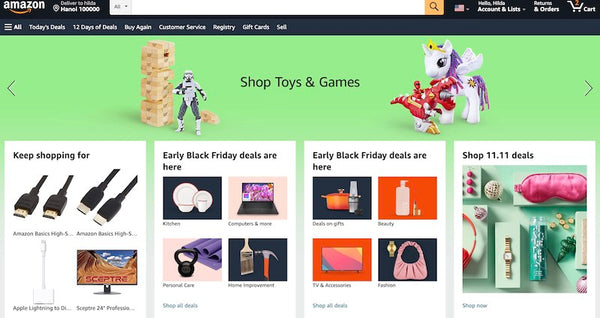Amazon’s artificial intelligence-powered recommendation system has revolutionized e-commerce, transforming how millions of customers discover and purchase products online. This sophisticated technology represents one of the most successful implementations of AI in retail, driving an estimated 35% of all purchases on the platform. By analyzing vast amounts of customer data and employing advanced machine learning algorithms, Amazon has created a personalized shopping experience that anticipates customer needs and preferences with remarkable accuracy.
The recommendation engine operates as the invisible force behind Amazon’s success, seamlessly integrating into every aspect of the shopping journey. From the moment customers land on the homepage to their final checkout, AI-driven suggestions guide their experience through features like “Recommended for you,” “Customers who bought this also bought,” and “Frequently bought together.” This personalization extends beyond simple product matching, incorporating real-time behavioral analysis, seasonal trends, and even sentiment analysis from customer reviews to create a truly individualized shopping environment.
What makes Amazon’s approach particularly powerful is its multi-layered methodology that combines collaborative filtering, content-based filtering, and hybrid models to deliver unprecedented accuracy in product recommendations. The system continuously learns and adapts, processing millions of data points, including browsing history, purchase patterns, search queries, and user interactions to refine its suggestions. This dynamic approach ensures that recommendations remain relevant and timely, adjusting instantly to changing customer preferences and emerging trends.
Understanding how Amazon leverages AI for product recommendations provides valuable insights into the future of e-commerce personalization and the transformative potential of artificial intelligence in retail.
The Technology Foundation: Amazon’s AI Architecture

Amazon’s recommendation system operates on a sophisticated technological foundation built around the proprietary A10 algorithm, an advanced evolution of the trusted A9 search algorithm. This system employs three fundamental principles that work in harmony to deliver personalized experiences.
Search Query Interpretation forms the first pillar, utilizing advanced natural language processing techniques to understand user intent beyond simple keyword matching. The system analyzes query structure, identifies relevant, and interprets semantic meaning to ensure search results align with customer expectations.
Relevance determination constitutes the second pillar, where the algorithm analyzes product metadata, including titles, descriptions, and backend search terms. The system prioritizes keyword placement and evaluates how well product information aligns with user queries, ensuring the most relevant items appear prominently in search results.
Engagement metrics represent the third pillar, incorporating click-through rates, conversion rates, and session duration to assess user interaction patterns. Products generating higher engagement receive increased visibility, creating a feedback loop that continuously improves recommendation accuracy.
The underlying infrastructure leverages machine learning and deep learning algorithms capable of processing vast amounts of data and identifying complex patterns and relationships. Matrix factorization techniques, including Singular Value Decomposition and Alternating Least Squares, analyze user-item interaction matrices to capture latent factors and user preferences.
Data Collection and Analysis: The Fuel of Personalization
Amazon’s recommendation engine draws insights from an extensive array of data sources, creating a comprehensive profile of each customer’s preferences and behaviors. The system analyzes user behavior and demographics, product attributes, saved and purchased items, ratings, trending products, location data, and user reviews.
Behavioral data collection encompasses browsing patterns, search queries, time spent viewing products, cart additions, and purchase history. This information reveals customer preferences, seasonal buying patterns, and emerging interests that inform future recommendations.
Product interaction analysis examines how customers engage with specific items, including reviews, ratings, and comparison activities. The system identifies sentiment patterns in customer feedback, using natural language processing to extract emotional indicators that influence recommendation algorithms.
Real-time data processing enables the system to adapt instantly to changing customer behavior. If a customer’s browsing suddenly indicates new interests, such as exploring gardening tools, the system immediately adjusts recommendations to reflect this behavioral shift. This dynamic responsiveness ensures suggestions remain current and relevant throughout the shopping journey.
Core Filtering Methodologies: How Recommendations Are Generated

Amazon employs multiple filtering approaches that work together to create highly accurate product suggestions, each addressing different aspects of the recommendation challenge.
Collaborative Filtering represents Amazon’s pioneering contribution to recommendation technology, detailed in their groundbreaking 2003 publication “Recommendations: Item-to-Item Collaborative Filtering.” This method analyzes the experiences of users with similar preferences to generate recommendations, comparing purchasing patterns and identifying products frequently bought together.
The collaborative approach excels in three key areas: diversity, offering customers a wider range of product choices; serendipity, introducing customers to products they might not otherwise discover; and novelty, effectively presenting new store offerings that align with customer interests. This method proves particularly effective for complex products like electronics or books, where specialist knowledge isn’t required for accurate recommendations.
Content-Based Filtering analyzes product characteristics, including titles, categories, descriptions, and specifications, to recommend similar items. If a customer enjoys a particular product, the system identifies others with comparable features and attributes. This approach ensures recommendations maintain thematic consistency with customer preferences while introducing variations that expand their shopping horizons.
Hybrid Models combine collaborative and content-based filtering to leverage the strengths of both approaches while mitigating individual limitations. This comprehensive methodology enables Amazon to address diverse customer needs and product categories effectively.
Advanced AI Features: Beyond Basic Recommendations
Amazon’s latest generative AI implementations have elevated personalization to unprecedented levels, creating truly individualized shopping experiences that adapt to specific customer contexts and preferences.
Personalized Product Descriptions represent a significant advancement in recommendation technology. Instead of displaying generic product information, the system now generates customized descriptions that highlight features most relevant to individual customers. For example, if a customer regularly searches for gluten-free products, AI intelligently positions “gluten-free” prominently within relevant product descriptions, even when this attribute appears at the end of standard listings.
Dynamic Title Optimization employs Large Language Models to edit product titles, emphasizing features most important to specific customers based on their shopping activity. An evaluator LLM challenges and improves these results, ensuring customers see the most accurate and informative product information possible.
Contextual Recommendations go beyond generic suggestions like “More like this,” providing specific, personalized recommendations such as “Gift boxes in time for Mother’s Day” or “Cool deals to improve your curling game” based on customer shopping patterns and seasonal relevance.
Real-Time Adaptation and Continuous Learning

Amazon’s recommendation system operates with remarkable real-time capabilities, continuously adapting to evolving user preferences and behavioral changes. The system generates recommendations in near real-time, ensuring customers receive up-to-date suggestions that reflect their current interests and needs.
Immediate Response Mechanisms trigger when customers add items to their cart, instantly generating recommendations for complementary products and accessories that other customers frequently purchase together. This immediate responsiveness enhances the shopping experience while increasing average order values.
Feedback Loop Integration continuously collects and analyzes user feedback, including ratings, reviews, and purchase history, to refine recommendation models and improve future accuracy. This adaptive learning ensures the system evolves with changing customer preferences and market trends.
A/B Testing and Optimization enables Amazon to evaluate different recommendation strategies, comparing approaches and algorithms to determine which deliver the best results in terms of user engagement, conversion rates, and customer satisfaction. This systematic experimentation ensures continuous improvement and optimization of the recommendation engine.
Business Impact and Future Implications
The success of Amazon’s AI-powered recommendation system extends far beyond customer satisfaction, driving significant business value and establishing new standards for e-commerce personalization. Reports indicate that personalized recommendations drive approximately 35% of purchases on Amazon, demonstrating the substantial impact of AI on revenue generation.
The system transforms passive online stores into active sales channels, creating opportunities for cross-selling and upselling while improving customer retention and loyalty. By anticipating customer needs and presenting relevant products at optimal moments, Amazon has created a competitive advantage that continues to strengthen with each customer interaction.
As AI technology continues advancing, Amazon’s recommendation system will likely incorporate even more sophisticated personalization features, potentially including voice-based recommendations, augmented reality product visualization, and predictive purchasing that anticipates customer needs before they’re consciously recognized. This evolution represents the future of e-commerce, where artificial intelligence creates seamless, intuitive shopping experiences that feel almost telepathic in their accuracy and relevance.




